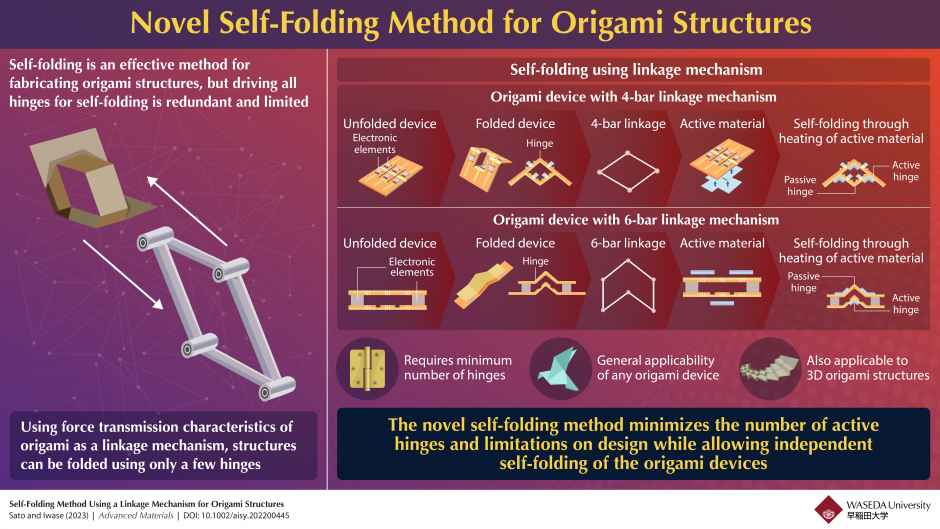Novel Method for Self-Folding of Origami Devices Using Linkage Mechanisms

Origami structures are garnering significant attention for fabrication processes in various fields, including medical care, robotics, and electronics, as they can smoothly transform from flat two-dimensional (2D) shapes to three-dimensional (3D) shapes. To achieve this transformation, self-folding is one of the most effective methods.
Self-folding works by adding special active materials to the hinges of a structure, which in response to external triggers, like heat and light, cause the structure to self-fold. However, it requires adding active materials to all the hinges, which limits design flexibility.
To address this issue, researchers led by Professor Eiji Iwase from Waseda University developed a new method for self-folding origami devices. In this method, the origami device is simplified into a linkage mechanism whose components transfer forces to each other. This allows the entire structure to self-fold by driving only a few specific hinges.
To control the self-folding of this linkage mechanism, the researchers needed to determine the required driving force and suitable positions on the structure to apply these forces using active materials. However, the required driving force varies, depending on the number of links, hinges, and folding angles. To solve this problem, they developed a new theory to control the self-folding of a structure, consisting of any number of links.
They used this method to fabricate two origami electronic devices. The first device consisted of light-emitting-diodes (LEDs) mounted on a 3D structure with five hinges, which can be simplified into a 2D four-bar linkage mechanism. The second was a 3D origami thermoelectric device with six hinges that can be modelled as a 2D six-bar linkage.
Both devices were fabricated by attaching a thick heat-shrinkable film to a substrate, which was then applied to drive the hinges to achieve self-folding. As a result of this method, only four of the five hinges needed to be driven for the first device and only three were required for the second device.
These results demonstrate that the proposed method achieves self-folding by controlling the driving force on a minimum number of hinges. Additionally, this method allows the addition of active materials at any time during the fabrication process, minimizing limitations and maximizing design flexibility. Furthermore, this method is also applicable to devices that can be modelled as a 3D linkage mechanism.
Overall, this innovative method can be applied to any origami structure to easily fabricate self-folding devices.
Link to the original journal article: https://onlinelibrary.wiley.com/doi/10.1002/aisy.202200445
About the author
Professor Eiji Iwase obtained his Ph.D. in Engineering from the Department of Intelligent Machine Informatics at the University of Tokyo in 2005. He is currently serving as a Professor at the Faculty of Science and Engineering, School of Fundamental Science and Engineering at Waseda University. He has over 200 publications with over 1000 citations to his name. He was also awarded the Waseda Research Award in 2017 for high-impact publications. Currently, he also leads the Micro & Nano Mechanics Laboratory at Waseda University. His research interests include micromachines and microelectromechanical systems (MEMS), nanofabrication, and actuators.








